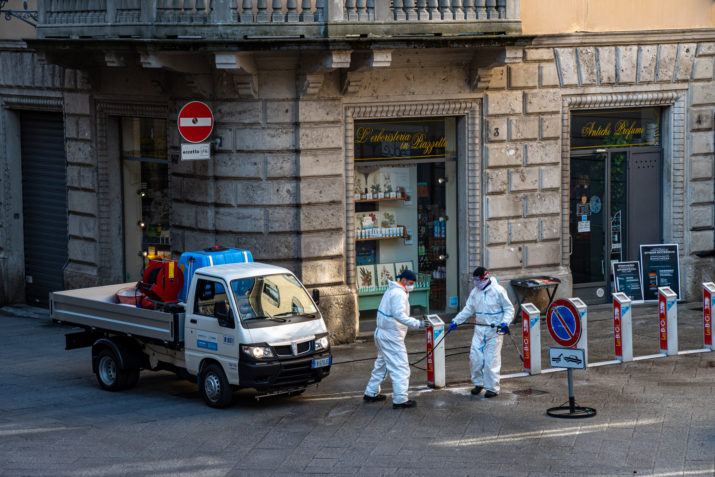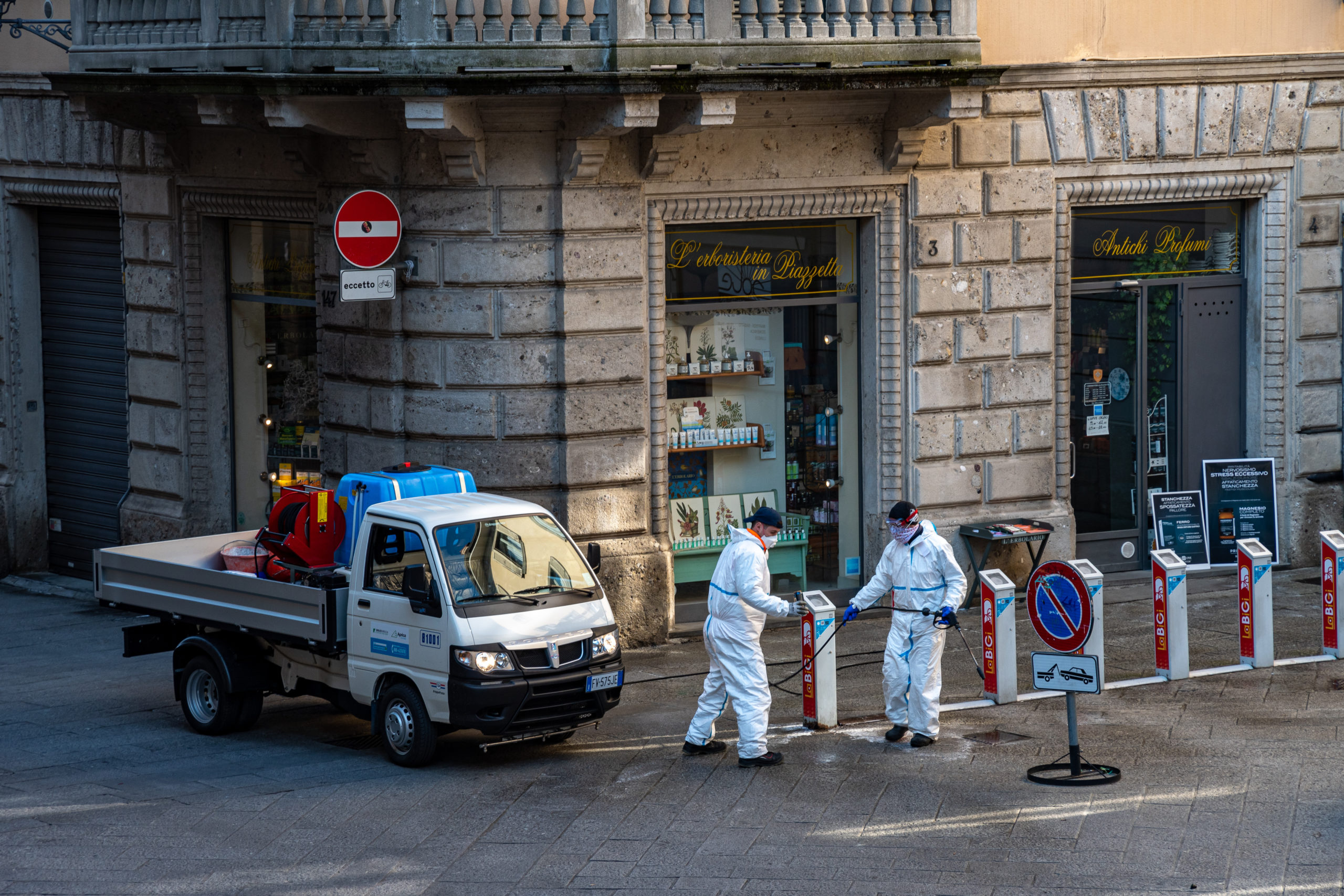

This is part of a series on the Novel Coronavirus (COVID-19) pandemic.
The novel coronavirus (COVID-19) was reported on December 31, 2019, when the Wuhan Municipal Health Commission in China informed the World Health Organization (WHO) of multiple cases of an unknown type of pneumonia. As the virus rapidly spread outside China, WHO issued a comprehensive set of guidelines for countries to help in detecting the new virus, while also discussing in an Emergency Committee (EC) whether the new pneumonia could constitute an international public health concern, but, as little was known about the virus, further research was needed.
Just two days after the virus spread was categorized as a pandemic, Europe recorded the largest number of cases outside of China (Ghebreyesus, 2020), testing the Union’s ability to cope with emergency health issues. In the wake of the outbreak, the European Commission, President Ursula von der Leyen, participated at the World Economic Forum (WEF) in Davos on January 22. She delivered her speech regarding climate change and briefly spoke about the efforts to end the Libyan civil war, but nothing was mentioned about COVID-19, although she referenced the need for stability and crisis prevention, just not in the health area. However, there was clearly no lesson learnt following the past outbreaks—SARS and MERS—as the EU overall did not anticipate or prepare for one of the biggest crises in contemporary history: the 2020 pandemic. On the same day, an important debate was held at WEF regarding the hazards brought about by COVID-19, during which Richard Hatchett (2020), former official in the White House specialized in epidemics, said that stopping an infectious disease “requires transborder cooperation” and he emphasized the importance of world leaders understanding the eventual crisis and finding solutions.
Though acting as a communitarian bloc, EU as an institution does not have health competencies itself. As per the Treaty of Lisbon, EU’s competences within the healthcare sector are centered on supporting its member states: coordinate or complement their actions (Fondation Robert Schuman, 2020). The efforts of the Commission were directed to public healthcare (finance for vaccines), borders and mobility (the green corridors for the shipment of goods and the repatriation of EU citizens), the fight against disinformation and online fraud, as well as economic measures (Mocanu and Vaș, 2020).
EU’s first step in assisting member states was the activation of the Civil Protection Mechanism, allowing the repatriation of EU citizens from all over the world. By the end of April, the scheme brought home over 500,000 citizens of the EU. The action begun after France has reported the first COVID-19 case in Europe on January 24 (European Commission, 2020a). The scheme was one of the most successful measures delivered by the Commission in collaboration with its partners, as most ways of transport were temporarily suspended due to the outbreak. Therefore, any European citizen wishing to return home was included in the rescue operation.
Additionally, on January 31, the EU allocated 10 million euro through the Horizon 2020 program to start researching the new virus, as reported by the European Commission. Not having competencies in health sector, the EU’s approach was less active and, in the beginning, focused more on researching the novel coronavirus, especially since a unanimous decision to temporarily close its borders and control the spread of the disease inside the bloc would have been a challenging task.
The first death had been recorded in France on February 14, and days later, Italy was the first European country to impose a lockdown as multiple cases of coronavirus were confirmed (Kretchmer 2020). Even when the virus closed Italy’s borders, the EU’s member states saw neither common guidelines, nor assistance from Brussels. One month later, on February 28, the European Commission slowly revealed its plans to prepare and respond. Furthermore, a joint mission to procure medical equipment with member states has been announced by the European Commission. The decision came late, considering the fact that the first cases were identified in Europe in late January and, since then, COVID-19 rapidly spread within the continent. As shown in von der Leyen’s WEF speech, the Commission was not ready or eager to prepare a plan to prevent a genuine healthcare and economic crisis inside the EU. On the same day, Italy activated the civil protection mechanism which allowed it to request medical protective equipment from other EU states. As the participation in the mechanism is voluntary and the situation was critical all over the continent, the request was ignored. It also generated the idea that there is an issue with the lack of protective equipment in case of a pandemic in the EU. Countries were barely managing themselves with the reduced number of face masks, ventilators and medication, hence helping yet another country was impossible.
However, panic grew in Europe as the beginning of March saw hospitals in Italy being overwhelmed. In the meantime, Brussels centered its interest, once again, on another high importance issue—the border with Turkey—where a threat of a new refugee crisis was looming. While the central EU leadership moved its attention from the coronavirus outbreak to the illegal immigration issues, the German government banned exports of any type of medical products and France took control over its medical equipment production (Wynne 2020). On March 12, ECDC announced that the new coronavirus had a high risk of transmission and containing it was “no longer […] feasible” (Wheaton & Deutsch, 2020). The statement marked the beginning of a new crisis in Europe with countries imposing large scale restrictions, such as deciding to close schools, universities, and shops, and limit public gatherings. The French President Emmanuel Macron was the first to announce a closure of schools and universities on the same day of ECDC’s message (Cuthbertson 2020).
Closing the borders was not initially a unanimous plan, as some countries restricted the entrance of non-citizens when the pandemic started (Rettman 2020). Meanwhile, the President of the European Commission immediately critiqued Slovakia and the Czech Republic after closing their borders for foreigners, as she argued it meant closing the European economy, which is the foundation of the Union. Additionally, Austria, Slovenia and Hungary suspended the passport-free access within the Schengen zone (Zalan, 2020). Besides, no country was willing to take any risk since the total number of infections and deaths constantly rose.
The EU as an institution failed to offer a fast and coordinated response to the rapidly growing rate of infections in Italy, the worst hit country inside the EU, a mishap which reflected badly on the EU’s reputation at the international level. Eventually, pressured by the frantic decisions of its members, EU leaders decided to apply a coordinated temporary closure of borders for all non-essential travel to the EU countries for an initial period of thirty days, starting on March 17. The border closure announcement seemed to arise only because most of the countries were already restricting non-citizens from entering their territory, not because it was deemed necessary by the Commission, which seemed more concerned about the economic consequences. Brussels wished to make the bloc appear stronger and efficient with a coordinated decision, not as individual countries acting together only during peaceful times, but it was way too late. In fact, EU’s priority was keeping the economy open in any case and granting the flows of goods. Countries imposed travel restrictions and compulsory quarantine, and enlarged their health capacities on their own, long before the unilateral decision of suspending all non-essential travel inside the Union.
As the crisis intensified faster than ever, the Commission published its guidelines for the European bloc on March 16. The document underlined the need to protect people while keeping goods and essential services available during the outbreak. It came as a measure to prevent an economic crisis, as countries were closing their borders and banning some exports such as medical equipment. In the meantime, EU leaders and officials began to be tested positive for coronavirus or self-isolate as a prevention (Brunsden 2020). This aroused a new wave of fear as everybody was vulnerable to the virus, irrespective of economic or social status.
On March 26, von der Leyen addressed the European Parliament on an unprecedented online meeting saying that “too many initially gave an only-for-me response” related to the pandemic. She again criticised member states for their decision to close borders without consulting the Commission or other states, as well as banning exports, thus acting in a way which was too individualistic for the community of states. It was a tough conference where the President claimed that her measures to stop the nonsense were the best way to save the Union. But in fact, she did not want to acknowledge that the “only-for-me” fight was legitimate, as the Commission’s plan to help member states was a poor and late response, given the limited competences of the EU in the field, as well as the difficulty of creating a coordination mechanism during the crisis. However, von der Leyen insisted to call for a coordinated exit strategy for a “back to normal” Union, but there were neither a timeline, nor a strategy so far (Wheaton 2020), albeit the plans were agreed upon in tough negotiations by the EU leaders in late July.
On May 27, von der Leyen announced a strategy for the EU recovery in the future in case of a similar crisis as the spread of a virus. The Next Generation EU strategy worth €750 billion is centred on three pillars: investing in repairing the social fabric, protecting the Single Market and rebalancing balance sheets in Europe. Although it represents a good plan following the previous crisis (SARS and MERS) and the coronavirus pandemic, it could have been better to have a strategy beforehand to manage a future crisis, especially since many health specialists warned long before of the possible effects of a pandemic.
The RescEU stockpile of medical equipment such as ventilators and protective masks was created at the end of March to help member states cope with the outbreak, as the process of preparing for a response means bureaucratic work at the highest level, member states have been caught without any noticeable resources, nor a collective response. In the meantime, each country found its own medical supply provider. The European Commission offered more financial support for its external partners, it strengthened its support in relation to the Middle East, as well as the Eastern Neighborhood countries, as the decision for these resided closer to Brussels than to the national capitals. Moreover, the Team Europe package has been launched in April to support the global response to COVID-19. The EU mobilized about €20 billion of external funding to help its partner countries all over the world during the pandemic (Jones et al 2020), focusing on three stages: responding to the health crisis, strengthening the healthcare systems and mitigating the socio-economic consequences of the pandemic. Undeniably, the financial resources for this came from an alternative budgetary plan directed for assistance and humanitarian support, but the member states should be as well a priority of the Commission during a pandemic. On the other hand, as the pandemic knows no borders, states should help each other in a crisis like this by using a global response strategy in the future. Additionally, a comprehensive global cooperation must be seen in order to prevent a future pandemic or crisis of a similar kind which could easily create chaos and affect international trade.
In April, the Commission issued guidance for states on how to support cross-border healthcare, meaning that it could help ease pressure on some saturated hospitals by sending patients to other countries. After the Commission’s request, Austria, Germany, and Luxembourg started to treat patients from Italy and France inside their country. Furthermore, a medical team from Romania and Norway was deployed to Italy through the EU Civil Protection Mechanism on April 7. Solidarity rose after months of seeing Italy fight with the massive rate of infection caused by COVID-19 and only three countries were willing to participate in the scheme. It may be because other countries did not have enough intensive care beds or other medical facilities to cope with more cases from outside their country. A total of 1.5 million face masks for healthcare workers were delivered by the Commission on the same day to seventeen member states and the United Kingdom. Additionally, twelve member states delivered through the EU Civil Protection Mechanism face masks, disinfectant and ventilators, mostly for Italy as it was the most affected country in Europe at that time.
A €2.7 million Emergency Support Instrument was activated on April 14, directly supporting member states’ healthcare systems. It was a necessary measure, but it came after a long period of seeing member states’ struggling to fight against the infectious disease. Additionally, a €1 billion funding for 100,000 small and medium-sized businesses (SME) has been unlocked from the European Fund for Strategic Investments (EFSI), as SMEs were the most economically affected during the pandemic, therefore, such funding was highly necessary. It was especially necessary because of border closures, as products were limited to be sold only inside the country, and in some cases, not even there.
Since the beginning of the outbreak in Europe, the approach has been different from country to country, rather than uniform. The European Union failed to offer the right solutions during critical times, such as immediate funding, border closure, and general support. As healthcare is strictly an individual member states’ competency, the mixed frustration, limited PPE resources, and ventilators escalated the crisis. It lacked preparation and a solid plan after the previous experiences with viruses such as MERS and SARS. In theory, guidelines and schemes of mutual assistance were right, but when transferred into practice, the European Union showed no cooperation and weakness in dealing with critical situations, such as a pandemic. Significantly, the biggest failure was ignoring the fast spread of the virus across other continents, as well as not considering the advice of epidemiologists. Furthermore, the bureaucracy inside EU institutions was an obstacle for most countries and receiving funding takes a long waiting time. After the pandemic, the European Union should follow a reform and structural plans on handling a possible future pandemic or return to its initial purpose of being an economic and trade union.
Diana-Andreea Mandiuc is a doctoral student, studying Politics and International Relations at Cardiff University, United Kingdom. Her research focuses on the online radicalization, the case of the UK female citizens. She recently completed a master’s degree in International Relations (Diplomacy) at the University of Birmingham, UK and is also a Freelance Journalist for several newspapers.
References:
Brunsden, Jim (2020), “Michel Barnier tests positive for coronavirus”, Financial Times¸ Accessed 10 June 2020,https://www.ft.com/content/cba10712-69f1-11ea-800d-da70cff6e4d3
Cuthbertson, Anthony (2020), “Coronavirus: France to close all schools and universities, Macron says”, Independent¸ Accessed 10 June 2020, https://www.independent.co.uk/news/world/europe/coronavirus-france-macron-covid-19-schools-a9398516.html
European Commission (2020), Press Releases
European Union External Action (2020), “Coronavirus: European Union launches “Team Europe” package to support partner countries with more than €20 billion”, Accessed 28 July 2020, https://eeas.europa.eu/headquarters/headquarters-homepage/77326/coronavirus-european-union-launches-%E2%80%9Cteam-europe%E2%80%9D-package-support-partner-countries-more-%E2%82%AC20_en
Fondation Robert Schuman (2020), “The European Union and the Coronavirus”, Accessed 28 July 2020, https://www.robert-schuman.eu/en/european-issues/0553-the-european-union-and-the-coronavirus
General Secretariat of the Council (2020), “Statement on the situation at the EU’s external borders”, Accessed 10 June 2020, https://www.consilium.europa.eu/en/press/press-releases/2020/03/04/statement-on-the-situation-at-the-eus-external-borders/
General Secretariat of the Council (2020), “Timeline – Council actions on COVID-19”, Accessed 10 June 2020, https://www.consilium.europa.eu/en/policies/coronavirus/timeline/
Ghebreyesus, Tedros (2020), “5,000 people have lost their lives to #COVID19 – this is a tragic milestone. Europe has now become the epicenter of the pandemic, with more reported cases and deaths than the rest of the world combined, apart from China.” Twitter, Accessed 10 June 2020, https://twitter.com/DrTedros/status/1238744995299024896
Hatchet, Richard (2020), “The Next Super Bug | DAVOS 2020”, World Economic Forum, Accessed 10 June 2020, https://www.youtube.com/watch?v=4NXHw5Jf4_s
Herszenhorn, David and Wheaton, Sarah (2020), “How Europe failed the coronavirus test”, Politico, Accessed 28 July 2020, https://www.politico.eu/article/coronavirus-europe-failed-the-test/
Jones Alexei, Sergejeff Katja, Sherriff Andrew, Teevan Chloe and Veron Pauline (2020), “The challenge of scalling up the European Union’s Global Response to COVID-19”, European Centre for Development Policy Management, Accessed 28 July 2020, https://ecdpm.org/wp-content/uploads/Challenge-Scaling-Up-European-Union-Global-Response-COVID-19-ECDPM-Briefing-Note-116.pdf
Kretchmer, Harry (2020), “Key milestones in the spread of the coronavirus pandemic”, World Economic Forum¸ Accessed 10 June 2020, https://www.weforum.org/agenda/2020/04/coronavirus-spread-covid19-pandemic-timeline-milestones/
Rettman, Andrew (2020), “Nine EU states close borders due to virus”, euobserver, Accessed 10 June 2020, https://euobserver.com/coronavirus/147742
Von der Leyen, Ursula (2020), “Keynote speech by President von der Leyen at the World Economic Forum”, European Commission, Accessed 10 June 2020, https://ec.europa.eu/commission/presscorner/detail/en/speech_20_102
Von der Leyen, Ursula (2020), “Speech by President von der Leyen at the European Parliament Plenary on the European coordinated response to the COVID-19 outbreak”, European Commission, Accessed 10 June 2020, https://ec.europa.eu/commission/presscorner/detail/en/speech_20_532
Von der Leyen, Ursula (2020), “Speech by President von der Leyen at the European Parliament Plenary on the EU Recovery package”, European Commission, Accessed 28 July 2020, https://ec.europa.eu/commission/presscorner/detail/en/speech_20_941
Wheaton, Jessica and Deutsch, Jillian (2020), “Containing coronavirus ‘no longer considered feasible,’ says EU agency”,Politico, Accessed 10 June 2020, https://www.politico.eu/article/containing-coronavirus-no-longer-considered-feasible-ecdc-says/
World Health Organization (2020), “WHO Timeline – COVID-19”, Accessed 10 June 2020, https://www.who.int/news-room/detail/27-04-2020-who-timeline—covid-19
Wynne, Amelia (2020), “Germany and France are condemned by other EU members after blocking the export of medical supplies, raising alarm among smaller countries hit by coronavirus”, Mail Online¸ Accessed 10 June 2020, https://www.dailymail.co.uk/news/article-8083527/Germany-France-condemned-EU-members-blocking-export-medical-supplies.html
Zalan, Eszter (2020), “Von der Leyen on virus: ‘EU will do whatever is necessary’”, euobserver¸ Accessed 10 June 2020, https://euobserver.com/coronavirus/147731
Photo: Bergamo, Italy – 2nd April, 2020 – Meticulous disinfection and decontamination on the streets as a prevention against Coronavirus disease (SARS-Cov-2), COVID-19 outbreak | Shutterstock
Published on November 10, 2020.




